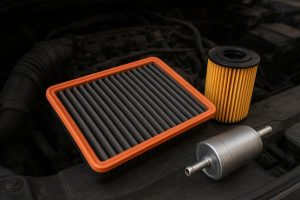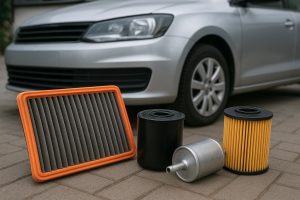When we think about vehicle maintenance, car filters often go unnoticed — yet they are among the most critical components ensuring that every system in your car functions efficiently and reliably. From engine protection to cabin comfort, filters keep unwanted contaminants out of vital systems. But what exactly is inside a car filter? How are these components built, and what makes one filter better than another?
Let’s take a closer look at the construction, materials, and multi-layered design of modern automotive filters.
The Core Purpose of Car Filters

A car filter’s job is simple in theory — to separate clean media (air, oil, or fuel) from contaminants such as dust, soot, metal particles, or pollen. However, achieving high filtration efficiency while maintaining optimal flow is a complex engineering challenge.
Each filter type performs a specific role:
| Filter Type | Function | Key Contaminants Removed |
|---|---|---|
| Air Filter | Cleans air before entering the engine | Dust, sand, pollen, soot |
| Oil Filter | Cleans engine oil | Metal shavings, carbon, sludge |
| Fuel Filter | Protects injectors and fuel pump | Rust, dirt, water droplets |
| Cabin Filter | Cleans air entering the cabin | Dust, allergens, exhaust gases |
Anatomy of a Typical Filter
While filter shapes vary — cylindrical, panel, or cartridge — most share the same fundamental components. Here’s what’s inside a typical air or oil filter:
| Component | Description | Purpose |
|---|---|---|
| End Caps | Metal or polymer covers sealing the filter media | Prevent unfiltered flow around the edges |
| Filter Media | The core material (paper, synthetic, or multi-layer composite) | Traps contaminants |
| Center Tube/Core | A perforated support structure | Provides rigidity, ensures flow stability |
| Gasket or Seal | Rubber or silicone ring | Ensures tight fit, prevents leaks |
| Outer Shell (Canister) | Metal or plastic casing | Protects internal components and maintains pressure |
| Bypass Valve (Oil Filters) | Opens when the filter is clogged | Ensures oil flow continues to prevent engine starvation |
| Anti-Drainback Valve | Found in oil filters | Keeps oil from draining out when the engine is off |
Layers Within the Filter Media
The heart of every filter lies in its filter media — a precisely engineered material with multiple layers designed to balance filtration and flow. Let’s explore these layers in detail.
Typical Filter Media Layers
| Layer | Composition | Function |
|---|---|---|
| Pre-Filter Layer | Coarse cellulose fibers | Captures large debris, extends filter life |
| Primary Filter Layer | Fine synthetic or cellulose blend | Traps smaller particles and dust |
| Electrostatic Layer (in premium filters) | Charged synthetic fibers | Attracts and holds microscopic contaminants |
| Support Mesh or Backing Layer | Metal or nonwoven polymer | Provides structure and prevents collapse |
| Activated Carbon Layer (Cabin Filters) | Charcoal granules | Adsorbs odors, exhaust gases, and VOCs |
| Antimicrobial Coating (Optional) | Specialized treatment | Inhibits bacterial growth inside the filter |
Key Materials Used in Filter Construction
Modern filters are built from a range of advanced materials, carefully selected for performance and durability:
-
Cellulose (Paper): Cost-effective, widely used, but has lower moisture and heat resistance.
-
Synthetic Fibers (Polyester, Glass Fiber, Melt-Blown Polypropylene): Offer higher filtration efficiency and better flow.
-
Activated Carbon: Used in cabin filters to trap gaseous pollutants and unpleasant odors.
-
Metal Components (Steel, Aluminum): Used in oil filters for strength and pressure resistance.
-
Rubber/Silicone: Ensures tight sealing and long-term durability under temperature extremes.
The Engineering Behind Layer Arrangement
The sequence and density of the layers are carefully optimized for each application. For example:
-
Air Filters prioritize airflow while stopping dust particles down to 10–20 microns.
-
Oil Filters handle pressures up to 7 bar and trap particles as small as 5 microns.
-
Fuel Filters demand ultra-fine filtration (1–5 microns) to protect injectors.
-
Cabin Filters balance particulate and gas-phase filtration to ensure passenger comfort.
A high-quality filter achieves a filtration efficiency of 98–99% while maintaining low flow restriction, meaning your engine or HVAC system doesn’t need to work harder to push air or fluids through.
Signs of Filter Wear and Why Replacement Matters
Over time, filters clog as contaminants accumulate, leading to several issues:
-
Reduced engine performance due to restricted airflow or fuel flow.
-
Increased fuel consumption as the engine compensates for reduced efficiency.
-
Higher emissions caused by incomplete combustion.
-
Unpleasant cabin air quality and foggy windows (for clogged cabin filters).
-
Possible engine damage if oil flow is restricted or unfiltered oil bypasses the media.
To prevent these problems, follow the replacement intervals recommended in your vehicle’s service manual.
Typical Replacement Intervals
| Filter Type | Replacement Interval* |
|---|---|
| Air Filter | Every 15,000–30,000 km |
| Oil Filter | With every oil change (10,000–15,000 km) |
| Fuel Filter | Every 30,000–60,000 km |
| Cabin Filter | Every 15,000–25,000 km |
*Intervals vary by driving conditions and filter quality.
Choosing the Right Filter for Your Vehicle

When selecting a filter, always consider:
-
Compatibility: Ensure it matches your car’s make and model.
-
Filter Media Quality: Synthetic and multi-layer designs perform better.
-
Brand Reputation: Trusted manufacturers provide tested, certified filtration performance.
-
Driving Conditions: Dusty or urban environments may require shorter replacement intervals.
-
Certification: Look for OEM-equivalent or ISO/TS 16949-certified products.
For a wide selection of reliable options, you can buy filters online — including air, oil, fuel, and cabin filters for virtually all vehicle models.
Final Thoughts
Understanding what goes on inside a car filter reveals how much precision and material science are involved in such a seemingly simple component. Each layer, seal, and fiber plays a role in keeping your engine clean, your cabin air breathable, and your vehicle performing efficiently.
Regular filter maintenance not only protects mechanical parts but also reduces fuel consumption, emissions, and long-term repair costs. Whether you’re performing routine service or optimizing your car’s reliability, investing in quality filters is one of the simplest — and smartest — decisions you can make.